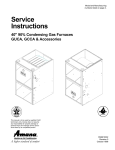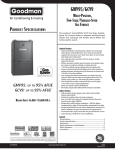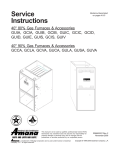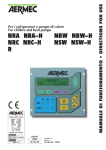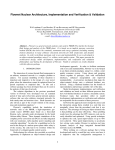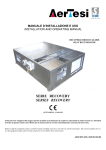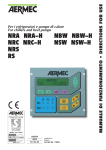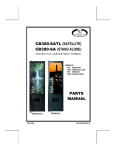Download GUCA GUSA GUVA HT. EX. REPL. KIT
Transcript
20219203 Installation Instructions Description With the improvements in the product design of the new 40” 90% model furnaces, the Primary and Secondary Heat Exchangers can now be replaced as a single unit thus eliminating the need to replace the entire furnace due to either a sooted or leaking heat exchanger or recuperator coil. The following installation instructions are for the Heat Exchanger Replacement Kit which contains the complete heat exchanger assembly along with the three pieces of gasket that are used between the heat exchanger assembly and inside partition rails. WARNING To avoid death, personal injury or property damage due to electrical shock, disconnect the electrical power supply before servicing this unit. R Kit # 20317301 20317302 20317303 20317304 20317305 20317306 20317307 20317308 20317309 20317310 20317311 20317312 20317313 20317314 20317315 20317316 Models Used On GUCA045**30 GUCA070**30 GUSA070**35 GUCA070**40 GUCA090**40 GUSA090**40 GUCA090**50 GUSA090**50 GUCA115**50 GUSA115**50 GCCA045**30 GCCA070**30 GCCA070**40 GCVA070**40 GCCA090**40 GCCA090**50 GCVA090**50 GCCA115**50 GUVA045**30 GUVA070**40 GUVA090**50 GUVA115**50 Heat Exchanger Replacement Kits WARNING Disconnect electrical power and shut off gas supply. I. Removal Procedures Note: Save all components and screws removed in the following procedures for reassembly. 1. After electrical power and gas supply have been turned off to the unit, remove burner compartment door. Note: On Counterflow model furnaces, the blower compartment door will also need to be removed to gain access to the incoming power lines to the furnace. The incoming power lines will need to be removed from the Counterflow model furnace since the furnace must be removed from the installation to gain access to the five Phillipshead screws located on bottom of the furnace that attach the top cover assembly to the furnace. 2. Next, disconnect and remove the gas supply piping to the furnace. In order to have enough clearance for removal of the heat exchanger assembly from the unit, all gas piping needs to be removed from the inner cabinet of the furnace. 3. Remove the attached ductwork and combustion air intake pipe (Direct Vent Only) and vent/flue pipe to gain access for removal of the top cover assembly on Upflow/Horizontal models. Units installed in the Counterflow position do not have the combustion air intake pipe or vent/flue pipe attached to the top panel assembly but require them to be removed because the entire furnace must be removed to gain access to the screws that secure the top panel assembly to the furnace. RECOGNIZE THIS SYMBOL AS A SAFETY PRECAUTION ATTENTION SERVICE PERSONNEL As a professional servicer you have an obligation to know the product better than the customer. This includes all safety precautions and related items. Remember, it is your responsibility to install the product safely and to know it well enough to be able to instruct a customer in its safe use. Prior to actual installation, thoroughly familiarize yourself with these instructions. Pay special attention to all safety warnings. Often during installation or repair it is possible to place yourself in a position which is more hazardous than when the unit is in operation. Safety is a matter of common sense...a matter of thinking before acting. Most dealers have a list of specific good safety practices...follow them. December 2001 The precautions listed in these instructions should not supersede existing practices but should be considered as supplemental information. 20219203 Rev. 1 4. Remove the rubber elbow that attaches the vent/flue pipe to the induced draft blower by loosening the two inner worm gear hose clamps along with removing the condensate drain line that is attached to the rubber elbow by a single hose clamp. After removing the rubber elbow, remove the top panel assembly by removing the screws that secure the it to the furnace. 7. Remove the manifold assembly by removing the four screws that secure it and the two pressure switches to the front of the heat exchanger on Upflow/Horizontal models only. The Counterflow/Horizontal models will also have four screws that secure the manifold assembly to the front of the heat exchanger but the two pressure switches are mounted on the blower deck, requiring the removal of two screws per switch for removal. Note: The top cover assembly has to be removed to gain enough clearance for removal of the heat exchanger assembly. The heat exchanger will need to be raised approximately 2" for removal from the furnace. Note: The pressure switch hoses do not have to be disconnected from the pressure switches since they are long enough for the pressure switches to be placed out of the way without their removal. If the hoses are removed, make sure they are reconnected to the correct pressure switch to ensure proper furnace operation. Note: Upflow/Counterflow Alternate Vent/Flue Location. To remove the inner vent/flue piping, loosen the two inner worm gear hose clamps that attach the rubber coupling to the vent/flue coupling and induced draft blower. Next, loosen the external worm gear hose clamp that attaches the short piece of PVC pipe to the externally mounted rubber elbow and the vent flue coupling. Remove the four screws from the vent/flue coupling and then remove it from side panel of the unit. 8. After removing the manifold assembly and pressure switches, the orifice shield can be removed by removing the two screws that secure it to the front of heat exchanger. 9. Next, the primary limit can be removed by removing the two screws that also secure it to front of the heat exchanger. After removing the manifold, pressure switches, primary limit and inducer motor, make sure that these components are placed out of the way to prevent them from being damaged upon removal of the heat exchanger assembly. Note: Horizontal Alternate Vent/Flue Location. To remove the inner vent/flue piping, loosen the two inner worm gear hose clamps that attach the rubber coupling to the induced draft blower and vent/flue coupling. Next, remove the four screws that attach the vent/flue coupling to cabinet. The rubber elbow in this installation is outside the cabinet and does not have to be removed. 10. The final step in getting the heat exchanger assembly ready for removal is to remove the screws that secure it to the inside partition panel rails of the furnace. Also the permagum that is located at the top corners (between the side panel, top cover and partition panel rails) and the bottom corners (between the side panel, blower deck and partition panel rails) must be removed. 5. Next, remove the condensate drain lines from the recouperator cover or induced draft blower (attached to ID Blower only in Horizontal Leftside Down Position). The PVC drain trap will also need to be removed from Counterflow models. 6. Next, remove the induced draft blower by removing the four screws that secure it to the front of recuperator cover. Disconnect the power leads, white (WH) and black (BL) wires, from the induced draft blower along with removing the green ground wire. 11. The heat exchanger assembly can now be removed by lifting the assembly approximately 2" and sliding it out of the unit. After removing the heat exchanger assembly from the furnace, inspect the gasket along the partition panel rails for any damage. If any of the gaskets are damaged, replace them with the new gaskets supplied in this kit. 2 Note: Upflow/Counterflow Alternate Vent/Flue Location. Secure the vent/flue coupling to side panel with the four screws removed in Step 4 of the removal procedures. Next, reconnect the rubber coupling to the induced draft blower and tighten the two inner worm gear hose clamps and then tighten the external worm gear hose clamp that attaches the externally mounted rubber elbow to the vent/ flue coupling. II. Reinstallation Procedures: The new heat exchanger assembly can now be installed in the furnace. 1. Slide the new heat exchanger assembly into the furnace and secure it to partition panel rails with the screws that were removed in Step 10 of the removal procedures. Note: Horizontal Alternate Vent/Flue Location. To install the inner vent/flue piping, reconnect the rubber coupling to the induced draft blower and gray vent/flue coupling and then tighten the two worm gear hose clamps. Reattach the gray vent/flue coupling to cabinet with the four screws also removed in Step 4 of the removal procedures. 2. Install the top cover assembly with screws that were removed in Step 4 of the removal procedures and then reinstall the permagum into the top corners between the side panel, top cover and partition panel rails and bottom corners between the side panel, blower deck and partition panel rails of the furnace. 3. Next, install the orifice shield onto the front of the new heat exchanger assembly with the two screws that were removed in Step 8 of the removal procedures. 9. Reconnect the ductwork, flue pipes and gas piping to the unit. NOTE: The incoming power lines will need to be reconnected on the Counterflow/Horizontal model furnaces installed in the counterflow position since the furnace had to be removed from the installation to gain access to the seven screws that attached the top cover assembly to the furnace. 4. After installing the orifice shield, install the manifold assembly along with the two pressure switches (Upflow/Horizontal Models Only) onto the front of the heat exchanger using the four screws removed in Step 7 of the removal procedures. On Counterflow/ Horizontal models, the pressure switches are not installed with the manifold assembly but are installed onto the blower deck using two screws per switch. NOTE: Before placing the unit in operation, leak test the unit and gas connections. Check for leaks using an approved chloride-free soap and water solution, an electronic combustible gas detector, or other approved testing method. Note: If the pressure switches are not installed correctly, it may be possible for switches along with the hoses to become filled with condensate causing the unit to cycle on either pressure switch and eventually lockout requiring. WARNING 5. Install the primary limit onto the front of the heat exchanger assembly using the two screws removed in Step 9 of the removal procedures. To avoid the possibility of explosion or fire, never use a match or open flame to test for leaks. 6. After installing the primary limit, install the induced draft blower onto the recouperator cover with the four screws removed in Step 6 of the removal procedures and then reconnect the two power leads (white (WH) and black (BL) wires) to the induced draft blower and secure the green ground wire back to the unit. WARNING Upon completion of the heat exchanger replacement, carefully inspect the entire flue system both inside and outside the furnace to assure it is properly sealed. Leaks in the flue system can result in serious personal injury or death due to exposure to flue products, including carbon monoxide. 7. Next, install the rubber elbow onto the induced draft blower and internal vent/flue pipe with the worm gear hose clamps that were removed in Step 4 of the removal procedures. Also reconnect the condensate drain line to the rubber elbow with the hose clamp also removed in Step 4 of the removal procedures. 8. Reconnect the condensate drain lines to the induced draft blower (attached to ID Blower only in Horizontal Leftside Down Position) and recouperator coil front cover with the hose clamps that were removed in Step 5 of the removal procedures. The PVC drain trap will also need to be reinstalled if removed. 10. Install burner compartment door and blower compartment door. 11. Restore power to the unit and check for proper operation. Verify proper gas pressures, static pressures and temperature rise on the unit. NOTE: If the gas pressures, static pressures and temperature rise are not within the ranges specified, this will result in premature unit failure. 3



